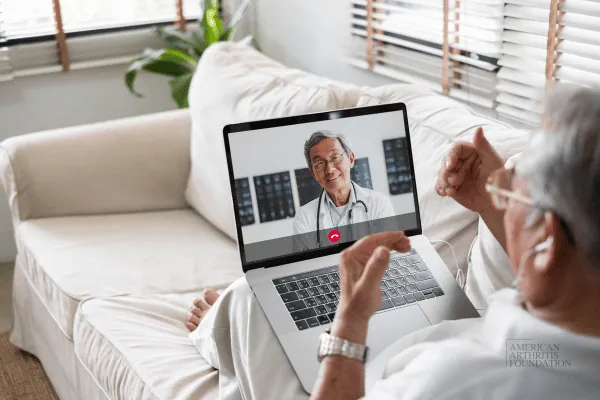About Arthritis
As the nation’s #1 cause of disability, arthritis affects nearly 60 million adults and 300,000 children. Over 100 types of arthritis and related conditions damage the joints and often other organs.
How can we assist you?
Helpful Tools for You

Can Telehealth and Training Enhance Treat-to-Target Strategies for Rheumatoid Arthritis?
Managing rheumatoid arthritis (RA) often requires a careful balance of medication, monitoring, and treatment adjustments. A proven strategy, known as "treat-to-target," focuses on setting specific goals—like reducing disease activity—and adjusting treatments based on how well those goals are met. However, despite the effectiveness of this approach, it’s often underutilized in routine care. So, what’s standing in the way of its full implementation, and how can we make it work better for patients? New research points to telehealth and enhanced training as two promising solutions to improve the management of RA.
Why Treat-to-Target Is Important (But Often Missed)
Treat-to-target is a patient-centered strategy that involves setting clear treatment goals with your healthcare provider (HCP) and regularly checking disease activity. If those goals aren’t being met, your treatment plan is adjusted to better manage symptoms. While this sounds like a recipe for success, research shows that less than half of RA patients receive the full benefits of this approach.
Dr. Laure Gossec, a professor of rheumatology at Sorbonne University, and her team found that treat-to-target strategies are often not fully followed. Many patients with high disease activity aren't receiving changes in their treatment plan when necessary, leading to ongoing pain, stiffness, and joint damage. The barriers? A combination of factors, including insufficient disease monitoring, lack of shared decision-making, and poor communication between HCPs and patients.
The Potential of Telehealth and Digital Tools
In an effort to identify ways to improve treat-to-target strategies, Dr. Gossec and her colleagues conducted an in-depth review of over 140 studies. They looked at what interventions might help overcome these barriers and ultimately improve outcomes for RA patients. The review highlighted that using telehealth services and digital tools could make a big difference in how well this approach is implemented.
Telehealth has the potential to improve communication and provide more frequent check-ins between patients and their healthcare providers. Regular video calls, phone appointments, and digital platforms can help track disease activity more closely and make it easier for patients to report any changes in their symptoms. This allows HCPs to make timely treatment adjustments, ensuring that patients stay on track with their goals.
One of the most promising tools identified in the review is electronic disease assessment. These tools can provide patients and their healthcare providers with real-time data on disease progression, enabling quicker adjustments in treatment when needed. For patients living in rural areas or those who have difficulty making regular in-person appointments, telehealth and electronic assessments offer a more accessible and convenient way to manage RA.
Training: A Key Component for Better Care
In addition to telehealth, the review stressed the importance of proper training for healthcare providers. Structured training programs that guide doctors and other HCPs in making informed decisions about when and how to adjust treatments can significantly enhance the effectiveness of treat-to-target strategies. These programs also emphasize the importance of educating patients about their role in managing their condition—empowering them to be active participants in their care.
The review suggests that by combining telehealth with targeted HCP training, RA management could see a significant boost. For instance, training healthcare providers to use electronic tools effectively, guiding patients in self-directed joint assessments, and offering feedback during telehealth visits could all contribute to better care.
What’s Next?
The study concludes that integrating telehealth and personalized training into treat-to-target strategies can help overcome many of the current barriers. However, these interventions need to be tailored to the individual needs of patients and HCPs to be truly effective. Personalized care, after all, is the foundation of the treat-to-target approach.
At the American Arthritis Foundation, we believe in promoting the latest research that can improve the lives of people living with rheumatoid arthritis. This study underscores the potential of using telehealth and training to make treat-to-target more practical, accessible, and effective for everyone.
Effects of Arthritis

Cause of Disability
In the United States, 23% of all adults, or more than 54 million people, have arthritis. It is a leading cause of work disability, with annual costs for medical care and lost earnings of $303.5 billion.

Workforce Effects
Sixty percent of US adults with arthritis are of working age (18 to 64 years). Arthritis can limit the type of work they are able to do or keep them from working at all.

Global Impact
In fact, 8 million working-age adults report that their ability to work is limited because of their arthritis. For example, they may have a hard time climbing stairs or walking from a parking deck to their workplace.
Promoting Interventions That Reduce Arthritis Pain
American Arthritis Foundation recognizes several proven approaches to reduce arthritis symptoms:
Be active. Physical activity—such as walking, bicycling, and swimming—decreases arthritis pain and improves function, mood, and quality of life. Adults with arthritis should move more and sit less throughout the day. Getting at least 150 minutes of moderate-intensity physical activity each week is recommended.
Protect your joints. People can help prevent osteoarthritis by avoiding activities that are more likely to cause joint injuries.
Talk with a doctor. Recommendations from health care providers can motivate people to be physically active and join a self-management education program. Should your arthritis be interfering with your activities of daily living you may be a candidate to receive many new treatments, and learn how to reverse the arthritis condition.


